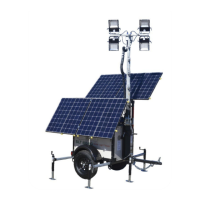51TriStar MPPT Operator’s Manual
50
Operation
5.0 Networking and Communication
5.1 Introduction
The TriStar MPPT 150V provides several communication options. The TriStar MPPT 150V uses a
proprietary protocol for the MeterBus
TM
network and the non-proprietary open standard MODBUS
TM
and MODBUS TCP/IP
TM
protocols for RS-232, EIA-485, and ethernet networks. Additionally, HTTP,
SMTP, and SNMP are supported for web page, email, and network message support.
Morningstar’s MSView
TM
PC software provides system monitoring and logging capabilities via RS-
232, EIA-485, and Ethernet. MSView
TM
PC software is available for free on our website at:
http://www.morningstarcorp.com
Further, hardware and third party software that supports the MODBUS
TM
protocol can also be used to
communicate with a TriStar MPPT 150V.
Multiple communication ports can be used simultaneously. For example, a TriStar MPPT 150V may
be connected to a MeterBus
TM
network for on-site system metering, connected to the internet for
remote monitoring, and connected to an EIA-485 network to bridge data from other controllers in the
system to an internet connection. Note that the RS-232 and EIA-485 connections share hardware and
therefore cannot be used simultaneously.
Table 5-1 below provides a summary of morningstarcorp.com/supported features for each communi-
cation interface.
MeterBus
RS-232
EIA-485
Ethernet
Display system/network data on a TriStar meter
●
Connect a TSMPPT to a Relay Driver or other MS Accessory
●
Connect multiple TSMPPT together in a network
●
●
●
View and log data with MSView
TM
PC Software
●
●
●
View logged data stored in the TriStar MPPT 150V internal memory
●
●
●
●
Update TriStar MPPT 150V rmware
●
Program custom settings
●
●
●
View data in a web browser
●
Email notication
●
Text Message Alerts
●
SNMP Alerts
●
Table 5-1. Communication summary
Schedule Maintenance Items
2 weeks after installation
Re-tighten power terminal connections to specified torque
values.
3 months after installation
Re-tighten power terminal connections to specified torque
values.
Monthly or After Each
Equalization
Inspect the battery bank. Look for cracked or
bulging cases, and corroded terminals.
For wet cell (ooded type) batteries, make sure the water level
is correct. Wet cell water levels should be checked monthly or
according to the manufacturer’s
recommendations.
Annually
Clean the heatsink fins with a clean, dry rag.
Inspect all wiring for damage or fraying.
Inspect for nesting insects.
Re-tighten all wiring terminal connections to specified torque
values.
Inspect the system earth grounding for all components. Verify all
grounding conductors are appropriately secured to earth ground.
Table 4-3. Maintenance Schedule

